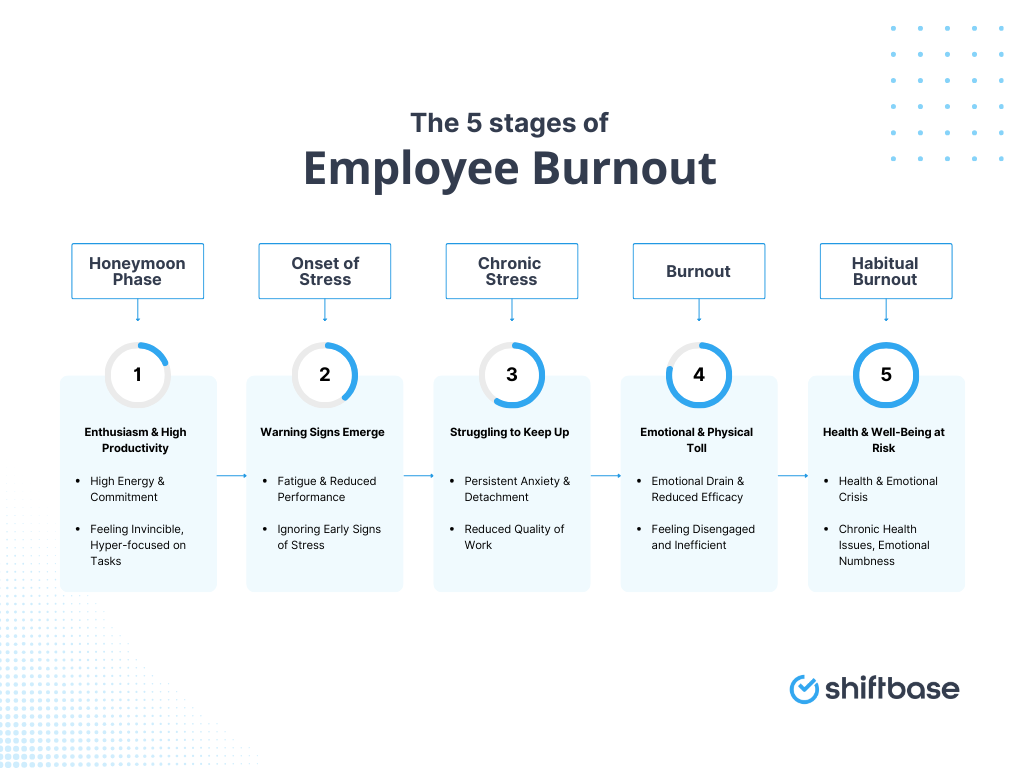As workplaces evolve, phrases like “chronic stress” and “burnout symptoms” have become all too common. As HR managers and small business owners, you’re juggling too many tasks and too many responsibilities.
Healthcare workers, in particular, have been significantly impacted by burnout, especially during the COVID-19 pandemic, making it crucial to address this issue.
It’s easy to focus solely on business metrics and overlook the mental and physical health of your team. But ignoring early signs of employee dissatisfaction and stress levels could result in occupational phenomenon—burnout—that affects not just individual well-being but also the productivity and longevity of your business.
From the honeymoon phase of new hires to habitual burnout, being attuned to your employees’ emotional and physical states is not just humane—it’s strategically imperative. Read on to understand how you can prevent burnout, ensure work life balance, and make employee mental and physical health a priority.
Employee burnout symptoms
When considering burnout, many mistakenly assume it simply manifests as emotional exhaustion or a pessimistic outlook. However, the symptoms are multifaceted, spanning both mental and physical health.
Understanding the Spectrum of Symptoms
From chronic headaches and weight gain to feeling anxious and increasingly intolerant, the indicators are often easily dismissed or misdiagnosed.
-
Mental Health Symptoms: Symptoms in this category often include emotional exhaustion, feeling anxious, or a pessimistic outlook. These are not just temporary moods but prolonged periods of such states that affect an employee's everyday life.
-
Physical Symptoms: Physical fatigue is another critical symptom that can arise from chronic stress, often leading to serious emotional and physical health issues if not managed properly. Weight gain, chronic headaches, and even bowel problems can be common symptoms. While these may seem unrelated to work, they are often direct outcomes of chronic workplace stress.
Useful Read: Stress Leave from work: Implications and Best Practices
How Symptoms Affect Work Performance
Early stages of these symptoms may not seem alarming, but if left unchecked over a prolonged period, they can evolve into a full-fledged burnout syndrome, significantly impacting work performance.
Employees may miss work deadlines, struggle with stress levels, and interact poorly with co-workers, leading to a toxic work environment.
Why Employers Should Be Concerned
Failure to identify and address these symptoms early can lead to dire consequences for your organization.
Employee absenteeism increases, productivity dips, and you may find yourself dealing with more serious issues that require medical attention.
The importance of recognising the stages of burnout for employers

It's More Than Just a "Phase"
In business management, the term "burnout" often takes a back seat to pressing concerns like deadlines, profits, and operational efficiency.
However, ignoring the stages of burnout can prove costly in the long run, affecting not only employee well-being but also organizational success.
-
Cost to the Business: When employees succumb to habitual burnout, the resulting absenteeism and reduced productivity can have financial implications. Over time, chronic stress in the workplace can create a domino effect, affecting team morale and work-life balance for everyone involved.
-
Liability Issues: Ignoring signs of burnout can put employers in a precarious legal position, as failure to address mental and physical health concerns may be considered neglect.
-
Brand Reputation: In the age of social media, unhappy employees are more likely to voice their dissatisfaction online, putting your brand reputation at risk.
Strategic Priority: Mental and Physical Health
Consider employee physical and mental health as strategic assets, akin to any other resource that contributes to your business’s success.
Recognizing the early signs and stages of burnout can save you not only in medical expenses but also in recruitment and training costs, should your valued employees decide to leave due to an unsupportive work environment.
Creating a Holistic Approach
Being proactive about burnout requires a shift in focus from merely preventing physical collapse due to workload to creating an environment where employees' own needs, both mental and physical, are acknowledged and respected.
Only by understanding the entire spectrum—from the honeymoon phase to habitual burnout—can you create a robust framework for employee well-being.
The stages of burnout

Understanding the stages of burnout is pivotal in creating effective strategies for prevention and intervention. These stages act as a roadmap, guiding employers on when to intervene and what actions to take.
1.The Honeymoon Phase: The Illusion of Invincibility
The journey often starts with the "honeymoon phase," where new tasks or a new job bring enthusiasm and commitment.
Employees are keen to prove oneself and willingly spend time to meet work deadlines and responsibilities. The idea of experiencing burnout seems far removed.
- Signs to Look For: Increased energy levels, optimism, and a desire to impress.
- Employer's Role: Maintain this enthusiasm by setting clear expectations and work-life balance guidelines.
2.Onset of stress: The First Red Flag
As tasks pile up and responsibilities grow, employees begin to feel the onset of stress. The to-do list grows longer, and so does the workday.
- Signs to Look For: More hours at work, feelings of anxiety, and trouble with sleep.
- Employer's Role: Implement workload management strategies and encourage employees to set boundaries.
3.Chronic stress: The Silent Aggressor
Chronic stress is the stage where stress becomes a constant companion, affecting both work and social life. It's a dangerous stage as employees might consider this the new normal, ignoring their own health.
- Signs to Look For: Frequent physical symptoms like chronic headaches, and mental states like emotional exhaustion.
- Employer's Role: Promote mental health awareness, offer resources for stress management, and consider revisiting workload allocations.
4.Burnout: The Breaking Point
At this stage, physical collapse and emotional breakdowns are more common, and symptoms of depression often manifest. It's a stage where many seek medical attention.
- Signs to Look For: Complete neglect of personal needs, a feeling of inner emptiness, and erratic sleeping patterns.
- Employer's Role: Immediate intervention is crucial. This may involve medical help, workload reduction, and psychological support.
5.Habitual burnout: The End of the Road
In this final stage, burnout is so ingrained that it becomes a part of the individual's personality, leading to long-term health issues and potentially catastrophic consequences for their career.
- Signs to Look For: Social isolation, sexual activity changes, and significant disruptions in everyday life.
- Employer's Role: At this stage, drastic measures are needed, including potential job reassignment, extended leave, or medical retirement.
Understanding these stages, their signs, and corresponding interventions can equip employers with the tools needed to address and prevent this occupational phenomenon, safeguarding not only their team's health but also their business's overall well-being.
The Impact of Burnout on Mental Health
Burnout can have a profound impact on an individual’s mental health, leading to a range of psychological consequences that can affect their overall wellbeing.
Understanding Psychological Consequences
Chronic stress and burnout can lead to a range of psychological consequences, including anxiety, depression, and emotional exhaustion. When left unaddressed, these consequences can have long-term effects on an individual’s mental health, making it essential to seek help from a mental health professional.
Burnout can also lead to feelings of self-doubt, cynicism, and reduced personal accomplishment, which can further exacerbate mental health issues. It is essential to recognize the signs of burnout and take proactive steps to prevent it, such as maintaining a healthy work-life balance, engaging in positive coping strategies, and seeking support from colleagues, friends, and family.
Long-term Effects on Employee Wellbeing
Habitual burnout can have severe long-term effects on an individual’s wellbeing, including physical symptoms such as headaches, fatigue, and sleep disturbances. Chronic workplace stress can also lead to physical health problems, such as cardiovascular disease, diabetes, and obesity.
Furthermore, burnout can affect an individual’s everyday life, making it challenging to maintain relationships, engage in hobbies, and enjoy activities outside of work. It is essential for employers to recognize the signs of burnout and take proactive steps to prevent it, such as providing mental health training, promoting work-life balance, and offering resources and support to employees experiencing burnout.
By understanding the psychological consequences of burnout and taking proactive steps to prevent it, individuals and employers can work together to promote mental health and wellbeing in the workplace.
Preventing Employee burnout: A Proactive Approach for a Healthier Workforce

In a demanding work landscape, preventing employee burnout should be at the forefront of organizational strategy.
Employers must approach this as a systematic issue requiring long-term solutions, rather than quick fixes.
Strategic Priority: Employee wellness
An organization can no longer afford to consider employee mental and physical health as secondary concerns.
Acknowledging them as strategic priorities can result in increased productivity and reduced turnover.
- Data-Driven Insights: Use metrics to gauge stress levels among employees. This data can be invaluable for implementing tailored interventions.
- Resource Allocation: Allocate resources, such as workshops and counseling, specifically aimed at stress management and burnout prevention.
Addressing toxic behaviours in the workplace
Toxic behaviors in the workplace, often dismissed or overlooked, can significantly contribute to burnout symptoms. These can range from micromanagement to hostile work environments.
- Open Dialogue: Create a channel where employees can report toxic behaviors anonymously.
- Immediate Action: Failing to act promptly on these reports can further deteriorate the work environment, leading to more stress and, eventually, burnout.
Creating inclusive work environments
Creating an inclusive work environment goes beyond diversity quotas or token gestures. It's about creating a space where employees feel genuinely valued and understood.
In an era where social life is often compromised due to work commitments, the workplace essentially becomes a second home for many.
If that home is characterized by social isolation and a lack of inclusivity, the effects on mental health can be detrimental, serving as a direct pipeline to burnout.
Team Building for Cohesion
Organizations should regularly host team-building activities aimed at strengthening bonds among co-workers.
From group exercises to problem-solving tasks, these activities promote communication and collaboration, reducing feelings of isolation.
Promote Open Communication
A sense of belonging also stems from how freely employees feel they can communicate—both with their peers and superiors. Channels for open dialogue should be easily accessible.
Training and Education
stereotypes can seep into the workplace, affecting interactions and promotions.
-
Sensitivity Training: Conduct regular sessions to educate employees on various forms of bias and how to avoid them.
-
Peer Reviews: Encourage peer-reviewed promotions to ensure multiple perspectives are considered, mitigating biases.
Workload balance and work life balance
Too many tasks and too many responsibilities without adequate time for personal needs can quickly lead to burnout. Here, Shiftbase's employee scheduling and hours registration features can be a game-changer.
- Time Management: Utilize time tracking tools to help employees manage their working hours better.
- Leave Management: Encourage employees to take time off to recharge, using automated leave request features.
Conclusion: Prevention is Better Than Cure
While there are many factors, both internal and external, that contribute to employee burnout, employers have a crucial role in preventing it.
Adopting a proactive approach—spotting early signs, cultivating a supportive environment, and utilizing technological solutions—can significantly reduce the risk of burnout, creating a more vibrant and productive workspace.
Leverage Shiftbase to Prevent Employee Burnout
Understanding the stages of burnout and recognizing its early signs is vital, but preventing it is even more crucial. With Shiftbase's robust employee scheduling, time tracking, and absence management features, you can ensure a balanced workload for your team, effectively minimizing stress levels.
Regular monitoring can allow you to intervene before burnout symptoms escalate, preserving both your employees' mental and physical health.
Don't let chronic workplace stress dictate the pace; take charge and cultivate a healthy, balanced environment for your team.
👉 Try Shiftbase for free for 14 days and see the difference it can make in preventing employee burnout. 👈






